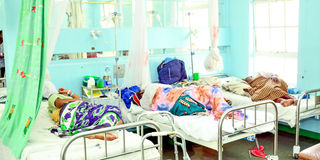Dropping the ball: Health system failing mothers

Mothers at Pumwani Maternity Hospital. Study shows grim maternal health statistics.
What you need to know:
- While the women live, the cost of nursing them back to health weighs heavily on the family and the taxpayer
- In every 1,000 live births, about seven women narrowly escape death (7.2 per 1,000 live births)
- The deaths were highest (15.6 per cent) in North Eastern and lowest (0.6 per cent) in Nyanza and Western
Giving birth is universally considered sacred and private, but when Jackline was about to deliver on Sunday last week at the gates of Pumwani Hospital, she was left alone and became a spectacle for everyone to record on phone and share on social media.
Public servants, whose job it is to protect such women, distanced themselves from the incident that caused a public outcry.
The incident comes in the wake of a research explaining why women like Jackline lose their lives and babies in their struggle to give birth.
The study, published in Nature by a researcher from the African Population and Health Research Center (APHRC) and his colleagues, describe instances where mothers miss death by a whisker.
From the study, other research and the interviews HealthyNation conducted with a gynaecologist in Kenya’s largest referral hospital, these incidents are caused by a missed diagnosis, botched abortions or a faulty guideline in the treatment schedule.
APHRC’s Dr Juma, one of the lead researchers, said while the women live, the cost of nursing them back to health weighs heavily on the family and the taxpayer who funds the health system. “These are the same reasons that cause maternal mortalities anyway,” Dr Juma told HealthyNation.
Severe outcomes
Records of patients rushed to 54 referral hospitals in 27 counties reveal a ghastly statistic: in every 1,000 live births, about seven women narrowly escape death (7.2 per 1,000 live births).
This is either through excessive bleeding after birth or hypertension in pregnancy (eclampsia) that were missed by the physician. Collectively and when deaths are involved, scientists term these as severe maternal outcomes. These were highest in the Rift Valley with 9.7 cases per 1,000 live births (1 per cent) and 5.1 cases per 1,000 live births (0.5 per cent) in the Eastern region.
The deaths were highest (15.6 per cent) in North Eastern and lowest (0.6 per cent) in Nyanza and Western.
The deaths and near-death events were highest in Eastern when the mother was transferred from one hospital to another, but highest (73 per cent) in Rift Valley before admission to the hospital. The highest cases (55 per cent) of women dying in the hospital were in Nyanza and Western.
Gynaecologist Wachira Murage, who is in private practice and works at Kenyatta National Hospital, said women miss deaths due to a diagnosis that escaped the physician. “Some sort of negligence, something that was missed out and it almost killed the woman, such as doctors not picking the seizures in women who have severe hypertension in pregnancies,” he explained.
Apart from the eclampsia and the bleeding after the birth, Dr Murage cited physicians missing out cerebral malaria and meningitis in pregnancy, which endanger mothers. The researchers also noticed that women came close to death because health workers could never identify when the body and its organs were not getting enough blood flow, a life-threatening condition called shock.
Require blood transfusion
Kenya’s guidelines on the treatment of expectant women may also be exposing them to danger. Dr Juma noted in his paper that the “Kenyan criteria for transfusion of two or greater units of blood and blood products in cases of severe anaemia in pregnancy, identified 60 maternal near-miss cases compared with 42 using the World Health Organization’s criteria of five or more units of blood”.
This deficient transfusion is not entirely the health workers’ fault, Dr Juma said. In June 2013, Kenya decreed maternal care to be free.
Therefore, the number of women delivering in health facilities increased as the number of health workers, budget, beds and medicine remained the same.
Researcher CM Gitobu from the Institute of Tropical and Infectious Diseases at the University of Nairobi in his paper in the journal BMC Pregnancy and Childbirth said while hospital deliveries increased by 29 per cent, “a nonsignificant decrease in the ratio of maternal mortality in the 77 health facilities was identified.
According to Dr Juma, if the required transfusion is five units and there are many women in need of that blood, doctors would rather share it among the women to save lives.
Dr Wachira told HealthyNation that the deficiencies in the system, such as stock-outs have forced many doctors to improvise to save the lives of mothers, sometimes with fatal consequences. Take the stockouts of Magnesium Sulphate, for instance, which is administered intravenously to the mother to prevent seizures if they have pregnancy-induced hypertension.
Cost of abortion
“When it is not there, doctors use alternatives such as Diazepam, a drug primarily meant for people with epilepsy,” Dr Wachira explained. Diazepam is highly discouraged for use in pregnant women.
Maternal near misses, perhaps even more than the deaths, are costly to the patient, the hospital and the public in general. Doctors Juma and Murage said women who experienced this will stay longer in the hospital, and will need to be attended to by more specialists and the procedures.
In a paper presented in a conference last year, Dr Juma and his colleagues analysed the cost of maternal near misses due to abortions and the results were startling.


